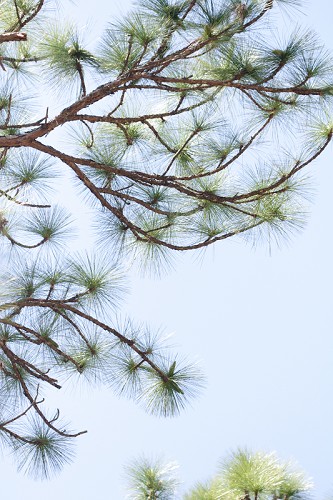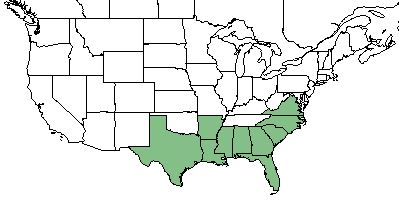Difference between revisions of "Pinus palustris"
(→Ecology) |
|||
| Line 33: | Line 33: | ||
===Habitat=== | ===Habitat=== | ||
Habitat falls largely within the southeastern Atlantic coastal plain and Gulf coastal plain. They require warm, wet, and temperate climates that have a steady reliable annual precipitation of 43-69 inches. It is common in sandy, well-drained soils close to sea level. <ref name= "USDA"> [https://plants.usda.gov/core/profile?symbol=CEAM USDA Plant Database]</ref> | Habitat falls largely within the southeastern Atlantic coastal plain and Gulf coastal plain. They require warm, wet, and temperate climates that have a steady reliable annual precipitation of 43-69 inches. It is common in sandy, well-drained soils close to sea level. <ref name= "USDA"> [https://plants.usda.gov/core/profile?symbol=CEAM USDA Plant Database]</ref> | ||
| + | |||
| + | Specimens have been collected from hardwood hammocks, longleaf pine scrub oak ridge, sandy soils with many oak species, and old longleaf stands. <ref name = "FSU herbarium"> URL: http://herbarium.bio.fsu.edu. Last accessed: June 2018. Collectors: Loran C. Anderson, R.K. Godfrey, Cecil R. Slaughter, Kurt Blum, S.W. Leonard, A. S. Jensen, S. L. Beckwith, Sidney McDaniel, S. Snedaker, D. B. Ward, Patricia Elliot, L. B. Trott, J. P. Gillespie, R. Komarek, Leon Neel, K. M. Meyer, A. Townesmith, Annie Schmidt States and counties: Florida (Franklin, Leon, Putnam, Washington, Orange, Citrus, Nassau, Marion, Wakulla, Liberty) Georgia (Harris) </ref> | ||
<!--Natural communities, human disturbed habitats, topography, hydrology, soils, light, fire regime requirements for removal of competition, etc.--> | <!--Natural communities, human disturbed habitats, topography, hydrology, soils, light, fire regime requirements for removal of competition, etc.--> | ||
<!--===Phenology===--> <!--Timing off flowering, fruiting, seed dispersal, and environmental triggers. Cite PanFlora website if appropriate: http://www.gilnelson.com/PanFlora/ --> | <!--===Phenology===--> <!--Timing off flowering, fruiting, seed dispersal, and environmental triggers. Cite PanFlora website if appropriate: http://www.gilnelson.com/PanFlora/ --> | ||
Revision as of 08:16, 7 June 2018
Common Names: Longleaf pine [1]
| Pinus palustris | |
|---|---|

| |
| Photo by John Gwaltney hosted at Southeastern Flora.com | |
| Scientific classification | |
| Kingdom: | Plantae |
| Division: | Magnoliophyta - Flowering plants |
| Class: | Magnoliopsida - Dicots |
| Order: | Pinales |
| Family: | Pinaceae |
| Genus: | Pinus |
| Species: | P. palustris |
| Binomial name | |
| Pinus palustris Mill. | |

| |
| Natural range of Pinus palustris from USDA NRCS Plants Database. | |
Contents
Taxonomic Notes
Synonym: P. australis (Michaux)
Variety: none
Description
Pinus palustris is a perennial tree of the Pinaceae family that is native to North America. [1]
Distribution
P. palustris is found throughout the southeastern United States; specifically in Florida, Georgia, South Carolina, North Carolina, Virginia, Alabama, Mississippi, Louisiana, Arkansas, and Texas. [1]
Ecology
Habitat
Habitat falls largely within the southeastern Atlantic coastal plain and Gulf coastal plain. They require warm, wet, and temperate climates that have a steady reliable annual precipitation of 43-69 inches. It is common in sandy, well-drained soils close to sea level. [1]
Specimens have been collected from hardwood hammocks, longleaf pine scrub oak ridge, sandy soils with many oak species, and old longleaf stands. [2]
Seed bank and germination
Germination needs mineral soil and 1-2 weeks after dispersal. Most germination occurs during the fall and spring. Only after the first two years of development, seedlings will begin to develop stems and growth in height begins to occur rapidly. During the first two years, the root system is developing, preparing for a rapid growth to extreme heights. [1]
Fire ecology
P. palustris requires frequent burning for a healthy environment. Without frequent burning, hardwood species will begin to overtake the habitat. P. palustris has a high fire tolerance. [1]
Use by animals
Birds and small mammals eat the large seeds, ants will eat the seeds that are germinating, and razorback hogs eat the roots of the seedlings.[1]
The tree provides habitats for bobwhite quail, white tailed deer, wild turkey, and fox squirrel. [1]
Red-cockaded woodpecker will use the old growth stands for nesting. [1]
Diseases and parasites
Hogs eat the seedlings during the initial stages of development.[1]
The brown spot needle disease can cause defoliation of the P. palustris tree. It is a fungus that occurs with a build up of dead grass on the forest floor and can spread to the young trees and seedlings. Frequent burning can reduce the likelihood of this disease spreading. [1]
Conservation and Management
Frequent fire is necessary to maintain a healthy forest of P. palustris. They grow in the place of dead trees, allowing for many tree of the same age to disperse to the same area where old trees have fallen. [1]
Excessive grazing of the forest floor will reduce the P. palustris in the region. [1]
Cultivation and restoration
P. palustris is ideal for reforestation in the proper climates; dry, seep sands in the southeastern United States. [1]
Photo Gallery
References and notes
- ↑ 1.00 1.01 1.02 1.03 1.04 1.05 1.06 1.07 1.08 1.09 1.10 1.11 1.12 1.13 USDA Plant Database
- ↑ URL: http://herbarium.bio.fsu.edu. Last accessed: June 2018. Collectors: Loran C. Anderson, R.K. Godfrey, Cecil R. Slaughter, Kurt Blum, S.W. Leonard, A. S. Jensen, S. L. Beckwith, Sidney McDaniel, S. Snedaker, D. B. Ward, Patricia Elliot, L. B. Trott, J. P. Gillespie, R. Komarek, Leon Neel, K. M. Meyer, A. Townesmith, Annie Schmidt States and counties: Florida (Franklin, Leon, Putnam, Washington, Orange, Citrus, Nassau, Marion, Wakulla, Liberty) Georgia (Harris)